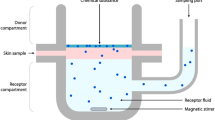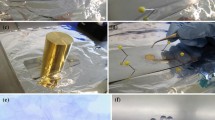Abstract
Purpose
The permeability coefficient (Kp) is often used for prediction of the dermal penetration of chemicals. Mathematical models have mostly been derived on Kp data basis. However, confusing Kp values are reported, questioning the general reliability of this parameter. In this study, we tested the plausibility of Kp values expressing the dermal penetration velocity (cm h−1) of chemicals on a larger dataset from literature.
Methods
Kp was applied for the calculation of the time for penetration through skin membranes of defined thickness (tCrossSkin). Kp values were obtained from Flynn’s dataset (1990), containing data determined mostly under similar experimental conditions using diffusion cells. Further skin penetration parameters, e.g., times at which the chemicals were firstly measured in the receptor phase, lag times, steady-state times, and exposure duration, where available, were related to Kp values. The data congruence was tested comparing Kp values from Flynn’s dataset with those reported in the EDETOX database. Variables, which could bias the results, such as different experimental protocols and research groups were also considered.
Results
Kp data for 94 chemicals matched the inclusion criteria were evaluated. According to the Kp values, 21 (22%) compounds would require longer than 100 h, and 20 (21%) further compounds longer than 10 h of exposure to penetrate skin membranes of ~ 0.01–2.5 mm thickness. Obviously, erroneous Kp were found in studies of almost all research groups in Flynn’s database, indicating that neither the observer nor the experimental conditions alone biased the values.
Conclusions
Our evaluation demonstrates high implausibility of Kp values to represent the dermal penetration velocity and supports general invalidity of the parameter for implementation in studies using skin membranes. The Kp should not be used to characterize the percutaneous penetration of chemicals or in risk assessment without verification.




Similar content being viewed by others
References
Abraham MH, Martins F, Mitchell RC (1997) Algorithms for skin permeability using hydrogen bond descriptors: the problem of steroids. J Pharm Pharmacol 49:858–865. https://doi.org/10.1111/j.2042-7158.1997.tb06126.x
Anderson BD, Higuchi WI, Raykar PV (1988) Heterogeneity effects on permeability-partition coefficient relationships in human stratum corneum. Pharm Res 5:566–573. https://doi.org/10.1023/A:1015989929342
Anissimov YG, Jepps OG, Dancik Y, Roberts MS (2013) Mathematical and pharmacokinetic modelling of epidermal and dermal transport processes. Adv Drug Deliv Rev 65:169–190. https://doi.org/10.1016/j.addr.2012.04.009
Arellano A, Santoyo S, Martín C, Ygartua P (1999) Influence of propylene glycol and isopropyl myristate on the in vitro percutaneous penetration of diclofenac sodium from carbopol gels. Eur J Pharm Sci 7:129–135. https://doi.org/10.1016/S0928-0987(98)00010-4
Barratt MD (1995) Quantitative structure-activity relationships for skin permeability. Toxicol In Vitro 9:27–37. https://doi.org/10.1016/0887-2333(94)00190-6
Behl CR, Flynn GL, Kurihara T, Smith W, Gatmaitan O, Higuchi WI, Ho NF, Pierson CL (1980) Permeability of thermally damaged skin: I. Immediate influences of 60 degrees C scalding on hairless mouse skin. J Invest Dermatol 75:340–345. https://doi.org/10.1111/1523-1747.ep12531096
Bouwman T, Cronin MT, Bessems JG, van de Sandt JJ (2008) Improving the applicability of (Q)SARs for percutaneous penetration in regulatory risk assessment. Hum Exp Toxicol 27:269–276. https://doi.org/10.1177/0960327107085829
Brain KR, Walters KA, James VJ, Dressler WE, Howes D, Kelling CK, Moloney SJ, Gettings SD (1995) Percutaneous penetration of dimethylnitrosamine through human skin in vitro: application from cosmetic vehicles. Food Chem Toxicol 33:315–322. https://doi.org/10.1016/0278-6915(94)00146-F
Bronaugh RL, Congdon ER (1984) Percutaneous absorption of hair dyes: correlation with partition coefficients. J Invest Dermatol 83:124–127
Brown MB, Lau CH, Lim ST, Sun Y, Davey N, Moss GP, Yoo SH, De Muynck C (2012) An evaluation of the potential of linear and nonlinear skin permeation models for the prediction of experimentally measured percutaneous drug absorption. J Pharm Pharmacol 64:566–577. https://doi.org/10.1111/j.2042-7158.2011.01436.x
Bunge AL, Persichetti JM, Payan JP (2012) Explaining skin permeation of 2-butoxyethanol from neat and aqueous solutions. Int J Pharm 435:50–62. https://doi.org/10.1016/j.ijpharm.2012.01.058
Chowhan ZT, Pritchard R (1978) Effect of surfactants on percutaneous absorption of naproxen I: comparisons of rabbit, rat, and human excised skin. J Pharm Sci 67:1272–1274. https://doi.org/10.1002/jps.2600670921
Cronin MT, Dearden JC, Moss GP, Murray-Dickson G (1999) Investigation of the mechanism of flux across human skin in vitro by quantitative structure-permeability relationships. Eur J Pharm Sci 7:325–330. https://doi.org/10.1016/S0928-0987(98)00041-4
Cross SE, Magnusson BM, Winckle G, Anissimov Y, Roberts MS (2003) Determination of the effect of lipophilicity on the in vitro permeability and tissue reservoir characteristics of topically applied solutes in human skin layers. J Invest Dermatol 120:759–764. https://doi.org/10.1046/j.1523-1747.2003.12131.x
Degim IT, Pugh WJ, Hadgraft J (1998) Skin permeability data: anomalous results. Int J Pharm 170:129–133. https://doi.org/10.1016/S0378-5173(98)00113-6
Dugard PH, Walker M, Mawdsley SJ, Scott RC (1984) Absorption of some glycol ethers through human skin in vitro. Environ Health Perspect 57:193–197
Dutkiewicz T, Tyras H (1967) A study of the skin absorption of ethylbenzene in man. Br J Ind Med 24:330–332. https://doi.org/10.1136/oem.24.4.330
Dutkiewicz T, Tyras H (1968) Skin absorption of toluene, styrene, and xylene by man. Br J Ind Med 25:243. https://doi.org/10.1136/oem.25.3.243
EDETOX (Evaluations and Predictions of Dermal Absorption of Toxic Chemicals) database. Newcastle. http://edetox.ncl.ac.uk. Accessed 27 March 2017
Elias PM, Cooper ER, Korc A, Brown BE (1981) Percutaneous transport in relation to stratum corneum structure and lipid composition. J Invest Dermatol 76:297–301. https://doi.org/10.1111/1523-1747.ep12526137
EPA (U.S. Environmental Protection Agency) (1992) Risk assessment forum. Guidelines for exposure assessment. Washington DC. https://www.epa.gov/sites/production/files/2014-11/documents/guidelines_exp_assessment.pdf. Accessed 27 March 2017
Fasano WJ, McDougal JN (2008) In vitro dermal absorption rate testing of certain chemicals of interest to the Occupational Safety and Health Administration: summary and evaluation of USEPA’s mandated testing. Regul Toxicol Pharmacol 51:181–194. https://doi.org/10.1016/j.yrtph.2008.04.005
Fitzpatrick D, Corish J, Hayes B (2004) Modelling skin permeability in risk assessment—the future. Chemosphere 55:1309–1314. https://doi.org/10.1016/j.chemosphere.2003.11.051
Flynn GL (1990) Physicochemical determinants of skin absorption. In: Gerrity TR, Henry CJ (eds) Principles of route-to-route extrapolation for risk assessment. Elsevier, New York, pp 93–127
Frasch HF, Barbero AM, Dotson GS, Bunge AL (2014) Dermal permeation of 2-hydroxypropyl acrylate, a model water-miscible compound: effects of concentration, thermodynamic activity and skin hydration. Int J Pharm 460:240–247. https://doi.org/10.1016/j.ijpharm.2013.11.007
Hadgraft J, Ridout G (1987) Development of model membranes for percutaneous absorption measurements. I. Isopropyl myristate. Int J Pharm 39:149–156. https://doi.org/10.1016/0378-5173(87)90210-9
Harville J, Que Hee SS (1989) Permeation of a 2,4-D isooctyl ester formulation through neoprene, nitrile, and Tyvek® protection materials. Am Ind Hyg Assoc J 50:438–446. https://doi.org/10.1080/15298668991374949
Hostýnek JJ (1998) Exposure to fragrances: Their absorption and potential toxicity. In: Roberts MS, Walters KA (eds) Dermal absorption and toxicity assessment. Marcel Dekker, New York/Basel, pp 601–623
Ishii H, Todo H, Sugibayashi K (2010) Effect of thermodynamic activity on skin permeation and skin concentration of triamcinolone acetonide. Chem Pharm Bull (Tokyo) 58:556–561. https://doi.org/10.1248/cpb.58.556
Johnson ME, Blankschtein D, Langer R (1995) Permeation of steroids through human skin. J Pharm Sci 84:1144–1146. https://doi.org/10.1002/jps.2600840922
Jolicoeur LM, Nassiri MR, Shipman C Jr, Choi HK, Flynn GL (1992) Etorphine is an opiate analgesic physicochemically suited to transdermal delivery. Pharm Res 9:963–965. https://doi.org/10.1023/A:1015877621976
Kezic S, Meuling WJ, Jakasa I (2004) Free and total urinary 2-butoxyacetic acid following dermal and inhalation exposure to 2-butoxyethanol in human volunteers. Int Arch Occup Environ Health 77:580–586. https://doi.org/10.1007/s00420-004-0540-3
Kirchner LA, Moody RP, Doyle E, Bose R, Jeffery J, Chu I (1997) The prediction of skin permeability by using physicochemical data. Altern Lab Anim 25:259–369
Koblick DC (1959) An enzymatic ion exchange model for active sodium transport. J Gen Physiol 42:635–645. https://doi.org/10.1085/jgp.42.3.635
Korinth G, Schaller KH, Drexler H (2005) Is the permeability coefficient K p a reliable tool in percutaneous absorption studies? Arch Toxicol 79:155–159. https://doi.org/10.1007/s00204-004-0618-4
Korinth G, Schaller KH, Bader M, Bartsch R, Göen T, Rossbach B, Drexler H (2012a) Comparison of experimentally determined and mathematically predicted percutaneous penetration rates of chemicals. Arch Toxicol 86:423–430. https://doi.org/10.1007/s00204-011-0777-z
Korinth G, Wellner T, Schaller KH, Drexler H (2012b) Potential of the octanol-water partition coefficient (logP) to predict the dermal penetration behaviour of amphiphilic compounds in aqueous solutions. Toxicol Lett 215:49–53. https://doi.org/10.1016/j.toxlet.2012.09.013
Krüse J, Golden D, Wilkinson S, Williams F, Kezic S, Corish J (2007) Analysis, interpretation, and extrapolation of dermal permeation data using diffusion-based mathematical models. J Pharm Sci 96:682–703. https://doi.org/10.1002/jps.20776
Lee Y, Hwang K (2002) Skin thickness of Korean adults. Surg Radiol Anat 24:183–189. https://doi.org/10.1007/s00276-002-0034-5
Megrab NA, Williams AC, Barry BW (1995) Oestradiol permeation across human skin, silastic and snake skin membranes: The effects of ethanol/water co-solvent systems. Int J Pharm 116:101–112. https://doi.org/10.1016/0378-5173(94)00321-U
Michaels AS, Chandrasekaran SK, Shaw JE (1975) Drug permeation through human skin: theory and invitro experimental measurement. AIChE J 21:985–996. https://doi.org/10.1002/aic.690210522
Moss GP, Cronin MT (2002) Quantitative structure-permeability relationships for percutaneous absorption: re-analysis of steroid data. Int J Pharm 238:105–109. https://doi.org/10.1016/S0378-5173(02)00057-1
Neubert R, Partyka D, Wohlrab W, Dettlaff B, Fürst W, Taube KM (1990) Penetration of salicylic acid and salicylate into the multilayer membrane system and into the human horny layer. Dermatol Monatsschr 176:711–716
Nitsche JM, Wang TF, Kasting GB (2006) A two-phase analysis of solute partitioning into the stratum corneum. J Pharm Sci 95:649–666. https://doi.org/10.1002/jps.20549
OECD (Organisation for Economic Co-operation ans Development) (2011) Guidance notes on dermal absorption. OECD Environmental Health and Safety Publications, Testing and Assessment Number 156, Paris, France. http://www.oecd.org/env/ehs/testing/48532204.pdf. Accessed 27 March 2017
Potts RO, Guy RH (1992) Predicting skin permeability. Pharm Res 9:663–669. https://doi.org/10.1023/A:1015810312465
Roberts MS, Anderson RA, Swarbrick J (1977) Permeability of human epidermis to phenolic compounds. J Pharm Pharmacol 29:677–683. https://doi.org/10.1111/j.2042-7158.1977.tb11434.x
Roy SD, Flynn GL (1989) Transdermal delivery of narcotic analgesics: comparative permeabilities of narcotic analgesics through human cadaver skin. Pharm Res 6:825–832. https://doi.org/10.1023/A:1015944018555
Sartorelli P, Andersen HR, Angerer J, Corish J, Drexler H, Göen T, Griffin P, Hotchkiss SAM, Larese F, Montomoli L, Perkins J, Schmelz M, van de Sandt J, Williams F (2000) Percutaneous penetration studies for risk assessment. Environ Toxicol Pharmacol 8:133–152. https://doi.org/10.1016/S1382-6689(00)00035-1
Scheuplein RJ (1965) Mechanism of percutaneous adsorption. I. Routes of penetration and the influence of solubility. J Invest Dermatol 45:334–346. https://doi.org/10.1038/jid.1965.140
Scheuplein RJ, Blank IH (1971) Permeability of the skin. Physiol Rev 51:702–747
Scheuplein RJ, Blank IH, Brauner GJ, MacFarlane DJ (1969) Percutaneous absorption of steroids. J Invest Dermatol 52:63–70. https://doi.org/10.1038/jid.1969.9
Schneider D, Dennerlein K, Göen T, Schaller KH, Drexler H, Korinth G (2016) Influence of artificial sebum on the dermal absorption of chemicals in excised human skin: a proof-of-concept study. Toxicol In Vitro 33:23–28. https://doi.org/10.1016/j.tiv.2016.02.010
Scott RC, Corrigan MA, Smith F, Mason H (1991) The influence of skin structure on permeability: an intersite and interspecies comparison with hydrophilic penetrants. J Invest Dermatol 96:921–925
Southwell D, Barry BW, Woodford R (1984) Variations in permeability of human skin within and between specimens. Int J Pharm 18:299–309. https://doi.org/10.1016/0378-5173(84)90145-5
Suhonen TM, Bouwstra JA, Urtti A (1999) Chemical enhancement of percutaneous absorption in relation to stratum corneum structural alterations. J Control Release 59:149–161. https://doi.org/10.1016/S0168-3659(98)00187-4
Vecchia BE, Bunge AL (2003) Skin absorption databases and predictive equations. In: Guy RH, Hadgraft J (eds) Transdermal drug delivery. Drugs and the pharmaceutical sciences, vol 123. Marcel Dekker, New York, pp 57–141
WHO (World Health Organisation) (2006) Environmental health criteria 235; dermal absorption, Hannover. http://www.who.int/ipcs/features/2006/ehc235/en/. Accessed 27 March 2017
Wilkinson SC, Maas WJ, Nielsen JB, Greaves LC, van de Sandt JJ, Williams FM (2006) Interactions of skin thickness and physicochemical properties of test compounds in percutaneous penetration studies. Int Arch Occup Environ Health 79:405–413. https://doi.org/10.1007/s00420-005-0056-5
Williams FM (2004) EDETOX. Evaluations and predictions of dermal absorption of toxic chemicals. Int Arch Occup Environ Health 77:150–151. https://doi.org/10.1007/s00420-003-0484-z
Wilschut A, ten Berge WF, Robinson PJ, McKone TE (1995) Estimating skin permeation. The validation of five mathematical skin permeation models. Chemosphere 30:1275–1296. https://doi.org/10.1016/0045-6535(95)00023-2
Acknowledgements
The present work was performed in fulfilment of the requirements for obtaining the degree “Dr. med.”
Author information
Authors and Affiliations
Corresponding author
Ethics declarations
Conflict of interest
The authors declare that they have no conflict of interest.
Electronic supplementary material
Below is the link to the electronic supplementary material.
Rights and permissions
About this article
Cite this article
Kladt, C., Dennerlein, K., Göen, T. et al. Evaluation on the reliability of the permeability coefficient (Kp) to assess the percutaneous penetration property of chemicals on the basis of Flynn’s dataset. Int Arch Occup Environ Health 91, 467–477 (2018). https://doi.org/10.1007/s00420-018-1296-5
Received:
Accepted:
Published:
Issue Date:
DOI: https://doi.org/10.1007/s00420-018-1296-5




